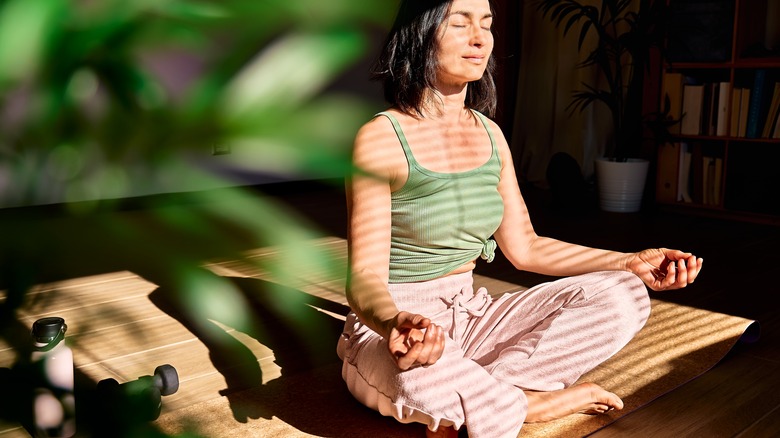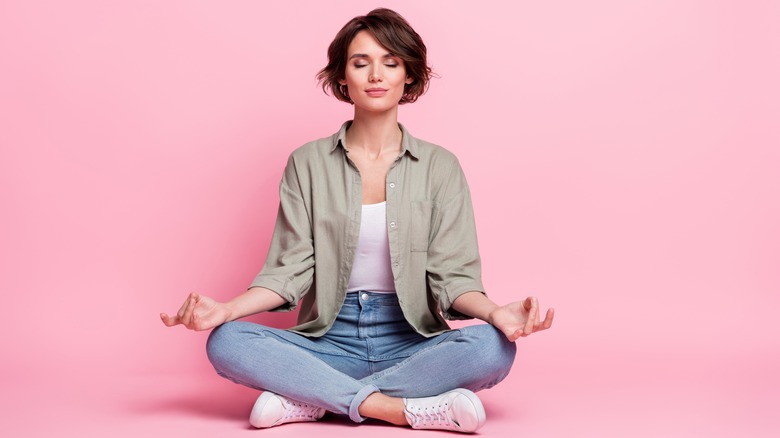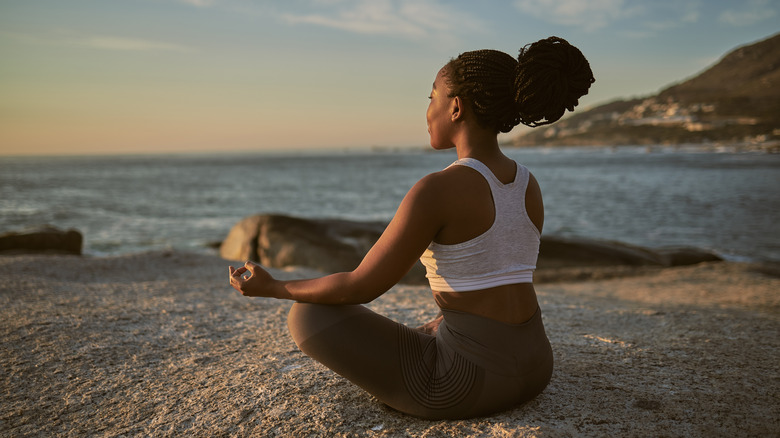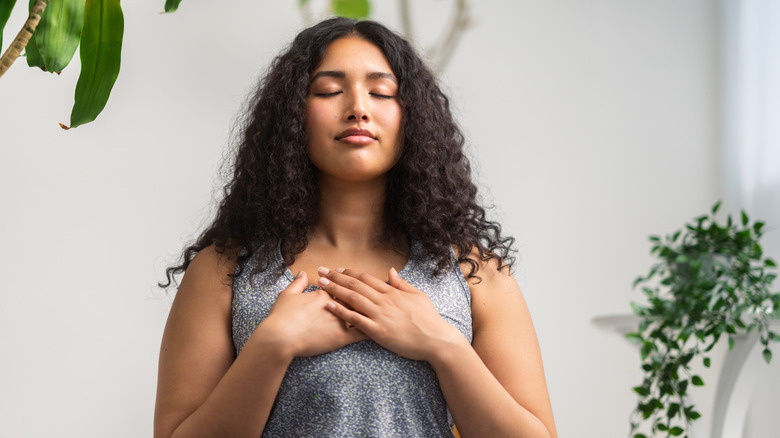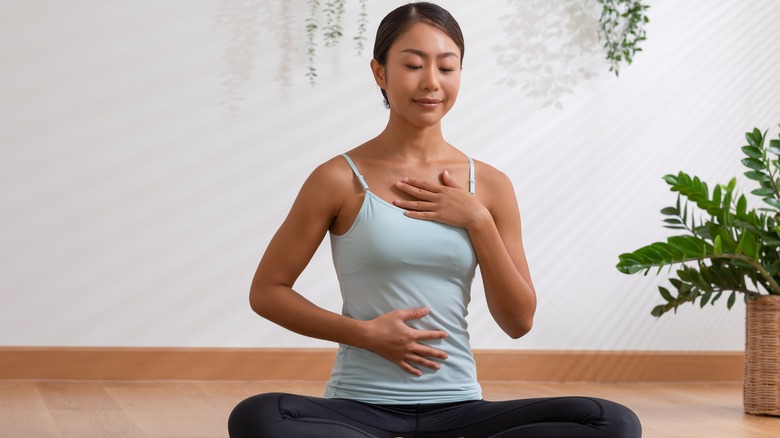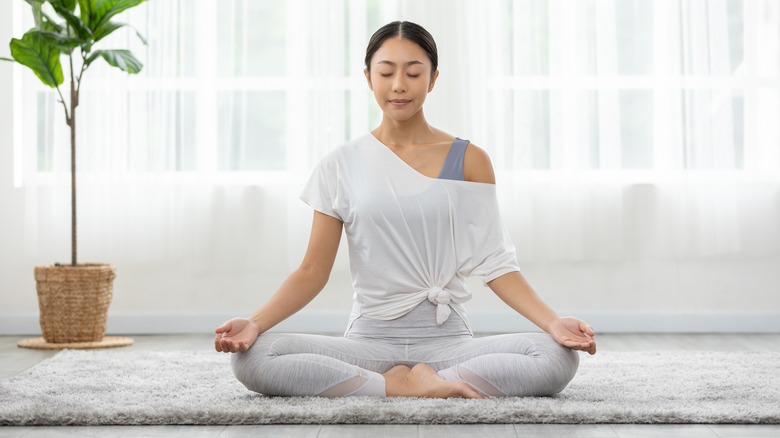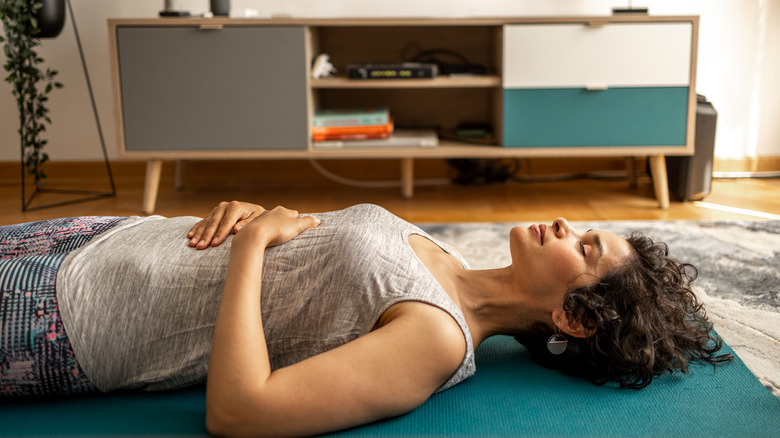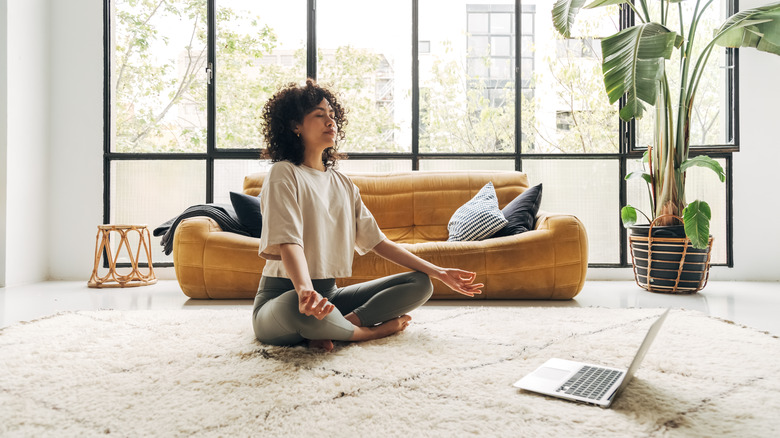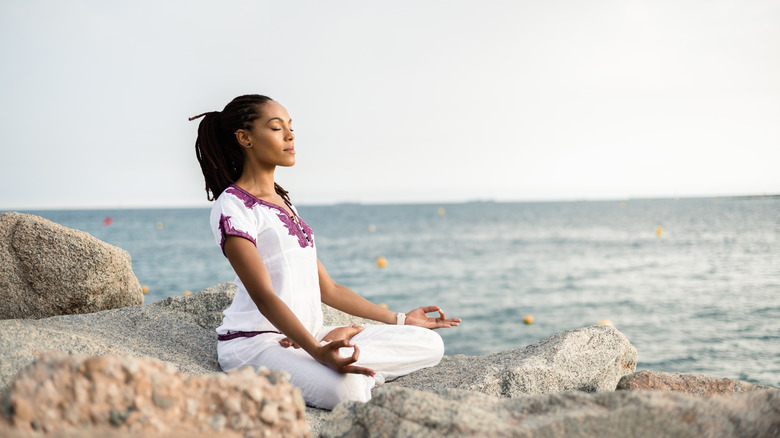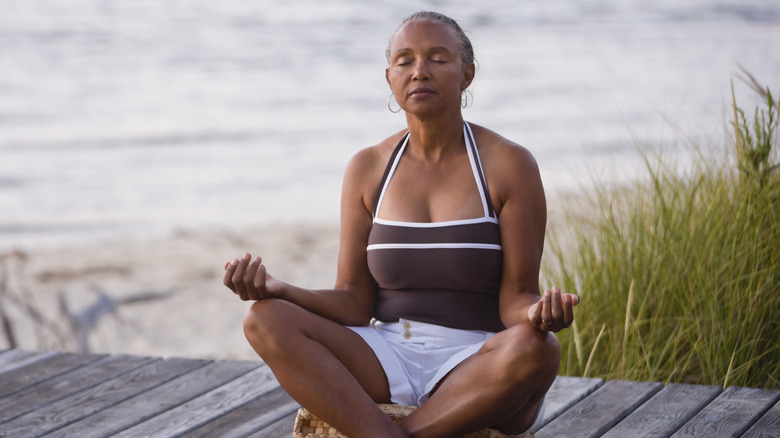So, Uh, How Do You Even Start Meditating Anyways? We've Got You Covered
Life has never been more stressful. In a 2021 Gallup poll, more than 40% of adults worldwide reported experiencing a significant amount of worry and stress, and more than a quarter of respondents reported feeling sadness. This set the record for Gallup's annual Global Emotions Report. So if you are feeling like the weight of the world is on your shoulders, rest assured that you are not alone.
Short of moving into a bubble on another planet, it's hard to avoid life's stressors. But you can learn to cope and achieve peace amid adversity — with no prescription required. The age-old practice of meditation is scientifically proven to help relieve stress, alleviate sadness, improve productivity and sleep, and boost physical health (via Mayo Clinic).
Want to gain the benefits but don't know where to start? Meditation is a skill you have to build. And just like any other skill, it takes time and practice. Follow our get-started guide and you'll be as cool as a cucumber in no time.
What is meditation?
Meditation originated in the East many thousands of years ago (via Positive Psychology). It traveled West a few hundred years ago but only became mainstream in the last few decades. Of course, the practice has changed over the centuries, and the contemporary practice probably looks much different than it did in previous centuries. But the goal is the same: to cultivate greater focus and awareness, to clear the mind of extraneous thoughts and worry, and to bring about greater peace of mind.
Meditation involves both mental and physical practices. Most often, it involves sitting still and quietly. But it can also include movement and even sound. There's not just one way to meditate. Meditation can look a lot like prayer, and you might wonder if it has religious associations. In some but not all cultures, it does. For some people, it's a spiritual practice, and for others, it's neither religious nor spiritual. The truth is, meditation is lots of things for lots of different people. You can make your meditation your own and adjust it to suit your personality and lifestyle.
Meditation also isn't just a practice you do for a limited period of time every day. You are meant to take pieces of it and practice them in your daily life, whether you're at work, talking to your mother, or in line at the grocery store behind that person who needs to price-check everything. That's an especially good time to practice.
Why meditate?
Why exercise? Why eat a healthy diet? Because it's good for you and can improve your health. The same is true for meditation.
Numerous studies have shown that meditation can have positive effects on many areas of health — both mental and physical. Research shows that its most common use among adults is for general wellness, followed by boosting energy and improving memory and concentration (via the National Institutes of Health). It has clinical value for mental health issues such as depression and anxiety, too. A 2014 research review in JAMA Internal Medicine found clear evidence in 47 studies that meditation had a marked effect on both of those conditions.
Stress relief is another common reason people meditate. Stress can have deleterious effects on mental and physical health. In fact, there's evidence that stress-related inflammation can have negative effects on the immune system and encourage the development or progression of disease. Meditation is highly effective for relieving stress as you're practicing, and also in the long term. Just sitting quietly and breathing can activate your body's parasympathetic nervous system and calm the stress, or "fight or flight," response, per UW Medicine. In a 2013 study, participants who took part in an eight-week mindfulness meditation course significantly reduced their body's inflammatory response to stress. It even has a role in the workplace, and major companies like Google, Intel, Aetna, and General Mills are offering mindfulness training to help employees reduce stress and increase effectiveness (via Forbes).
Build a meditation habit
Although a few minutes of deep breathing after a stressful event can help you feel calmer, you have to practice regularly to get the full benefits of meditation. Just as with exercise, it's an activity you need to commit to in order to reap long-term benefits.
So how do you build a meditation habit? The same way you build any habit. Don't bite off more than you can chew at first. Set a reasonable goal that you're going to meditate for five minutes each day. That's enough to start. The main factor is showing up every day. Regularity is how you make a habit stick. You may have to use willpower at first, but after a while, it becomes automatic. According to a 2021 study, it took participants an average of 59 days to achieve "peak automaticity." That's less than two months!
Schedule your meditation on your calendar just like any other appointment, and don't cancel on yourself. It helps to meditate at the same time every day and to find an accountability partner. Maybe a friend or family member is also interested in building a meditation habit. Keep each other on track by communicating daily about your practice so you keep showing up. You can also share experiences and tips on what's working for you or not working. Also, remember to give yourself a break if you miss a day — you can't build a healthy habit by beating yourself up.
Make a schedule and a space
When you choose to meditate is entirely up to you. Many people prefer to meditate in the morning. If you save it until later in the day, it might get pushed aside due to other things getting in the way. However, if you have a lot of responsibilities in the morning, such as getting the kids off to school, another time of day may work better for you. If evenings are quiet at your house, perhaps you meditate as part of winding down for sleep at night. This is an especially good time if you find you have trouble calming your mind and falling asleep.
Where you meditate is also important. Ostensibly, you could meditate on a crowded subway train. However, that's probably not the best place, especially in the beginning. Choosing a quiet place where you feel calm and safe is recommended. Pick a place in your home where you're least likely to be disturbed by family members or roommates. Make this place your meditation space and practice there regularly. You don't need any props to meditate, but sometimes they can help make you more comfortable or create a good vibe. Sitting on a pillow or folded blanket can be more comfortable than sitting on a hard floor. You might also use aromatherapy during your practice by placing an essential oil diffuser in your meditation area. If you tend to get chilly, leave a soft shawl or blanket to wrap up in.
Take advantage of technology
Need some meditation inspiration? Look no further than your cell phone. You can find tons of guided meditations online — many for free. Check out the meditation app Headspace, which offers a large variety of guided meditations for beginners. It also offers courses that will lead you through a structured meditation education. If you're really interested in becoming a master meditator, a subscription is worth the time and money investment. You can find plenty of meditation classes online from Insight Meditation Society and well-known Buddhist meditation teacher Tara Brach.
For those who aren't quite sure about this meditation thing yet, there's A Skeptic's Path to Enlightenment led by meditation teacher Scott Snibbe. If you like podcasts, you can also check out Snibbe's series of the same name. Other options for podcast enthusiasts include Meditation for Women, The Mindful Minute, and Soul Sistas Sleep Meditations. Art lovers will appreciate the Rubin Museum of Art's weekly mindfulness meditation that focuses on a different artwork in each episode.
Practice breath meditation
An easy way to start with meditation is just to sit quietly and breathe. Deep breathing activates the parasympathetic nervous system to get you out of stress mode (via the University of Toledo). The sound and feeling of your breath give your mind something to focus on so you're not thinking about that meeting with your boss or what you're going to have for dinner.
To get started, sit in a comfortable position. You can try cross-legged on the floor on a cushion or folded blanket, or you can sit in a chair. Place your hands on your thighs and sit up tall. Close your eyes. Inhale through your nose for a slow count of four, then exhale for a slow count of four. Continue to repeat this rhythm. As you breathe, focus your mind on the sound your breath makes and the sensations that come up as it enters your nostrils and lungs. Clear your mind of all other thoughts. If you find a thought that creeps into your head, simply return your focus to the breath. When you're finished, sit quietly and assess how you're feeling compared to when you started the meditation.
Try a mindfulness meditation
Mindfulness is a practice that involves staying aware of the present moment rather than letting your mind wander. This can have a wide array of beneficial effects, including reducing stress and anxiety, improving focus and concentration, and helping you control strong emotions (via The Harvard Gazette). It can even help you to be more empathetic.
To do a simple mindfulness meditation, sit quietly with your eyes closed. For the next five to 10 minutes, or however long you have set aside for your practice, simply observe the present moment. Let thoughts float by like clouds, noticing them, but not passing any judgment. If you notice yourself getting lost in a particular thought, or passing judgment, let go of it and let it float past. Return to the present. Continue to do this as thoughts pop up, never holding on to a thought, but staying in the present moment simply as an observer. At first, this can seem quite challenging. Just do the best you can. With time and practice, it gets easier.
Do a body scan meditation
A body scan is another type of mindfulness meditation. In this practice, you focus on one part of your body at a time, noticing any sensations you feel. Mindful recommends setting aside 30 to 40 minutes to do a full body scan practice, but if you only have 10 minutes, that's fine too. This is a great time to use technology, as you might find it easier to have someone else lead you through a body scan your first time. Body scan meditations can be done seated or while lying down. If you do it lying down, just be sure not to fall asleep!
Start by focusing your full attention on your body. Take several deep breaths. As you begin to relax, bring your focus to your feet. Become aware of your heels on the floor, and take note of any sensations you feel — such as pressure, heat, or cold. Then move your attention up to your legs. Notice any sensations in your ankles, lower legs, knees, and thighs. Do they feel heavy or light? Hot or cold? Do you feel any vibrations? Continue this awareness up to your back — lower, middle, and upper spine. Then focus on your belly. Move to your hands, your arms, then your shoulders. Focus on your chest, neck, and face. Take time at each place to really become aware. Then, come back to your whole body awareness. Take a few more deep breaths and open your eyes.
Choose a meditation mantra
A mantra is a word or phrase that you repeat to yourself while you're meditating. This has two purposes. The first is to give you something to focus on instead of your thoughts. If you are having trouble with this aspect of meditation, a mantra can help. When you're focused on repeating your mantra with each inhale and exhale, it's harder for thoughts to intrude. The second purpose of a mantra is to focus on your intention. If you are doing a meditation with a particular theme, such as gratitude, you can choose a word or phrase that is relevant. For example, "I am grateful." Your mantra can be repeated on the inhale or the exhale, or you can break it up, saying part on the inhale and part on the exhale. You can also choose to say your mantra aloud or repeat it silently in your head.
There's no right way to come up with a mantra. Simple phrases like "I am content at this moment," or "Everything I need is within me," are some examples. If you are religious or spiritual you can choose a relevant, meaningful mantra. Yoga practitioners often use a mantra from Sanskrit, such as "Om shanti shanti shanti." "Shanti" translates to "peace" (via Mindworks). A simple mantra to start with your first time is to simply repeat "inhale" as you inhale and "exhale" as you exhale.
Meditate while you move
Sitting still isn't the only way to meditate. You can also do a walking meditation. Find a quiet place where you can walk undisturbed for about 10 to 15 steps. This can be either inside or outside. Some people like to do walking meditations in nature. Take 10 to 15 steps in one direction, and stop and take several deep breaths. Then turn around and walk in the other direction for 10 to 15 steps. In the end, stop and breath for a while. Continue to repeat. Walk slowly, and focus very closely on each step. Take notice of how you raise your leg to take a step, how your foot moves out in front of the other, the pressure on the foot when you put it down on the ground, and then how you shift your body weight to take your next step. If you lose focus, or you find external thoughts creeping in, simply bring your attention back to your body. Practice this for five to 10 minutes, or more.
If you like to do yoga, you can also bring your meditation practice to your yoga mat. Be mindful as you move, noticing the sensations of your body. Sync your breaths with your movements, and stay in the present moment rather than thinking of the past or future.
Accept obstacles and practice self-compassion
How you imagine your meditation practice and how it actually manifests can be very different. You picture yourself sitting serenely in a state of bliss, while in reality, you're fidgety and unfocused. One minute you're mindfully repeating your mantra and the next moment, you're making a mental shopping list. That's perfectly normal as you're starting out, so don't beat yourself up — and don't give up. You might feel like you don't want to be meditating while you're sitting there, or you might have trouble even beginning your meditation. That's also normal. Rest assured there are likely some Buddhist monks who don't always feel like meditating, but they do it anyway.
You might also find yourself thinking that meditation is futile — that all the effort you're putting in isn't going to amount to anything, so why even bother doing it? The trick is to keep showing up. As you continue to show up for your meditation practice on a daily basis, these obstacles will gradually subside. You'll begin to feel less fidgety, your mind will stay clear for longer, and you'll come to enjoy and look forward to your meditation — most of the time. Don't try to achieve 100% perfection — in meditation or anything else in your life. Just do your best and accept imperfection. That's part of the journey.
Don't give up
Just the act of sitting quietly and breathing can have an immediate effect on your stress level and mood state. That's reason enough to stick with your meditation. However, you might not get the full benefits of your practice for some time. Just like any new skill you learn, you won't get really "good" at it until you've practiced many times.
Sticking with it is worth it. Science has proven the long-term benefits of regular meditation, and research shows that many people can see marked benefits from a daily meditation practice in just a couple of months. One study found that participants who meditated for 13 minutes a day for two months saw measurably improved memory and reduced stress and anxiety (via The Harvard Gazette). This and other studies have shown that long-term meditation can actually alter brain structure resulting in lasting changes in well-being and quality of life. So don't give up when the going gets tough. As Ashtanga yoga master Sri K. Pattabhi Jois often said, "Practice and all is coming."
